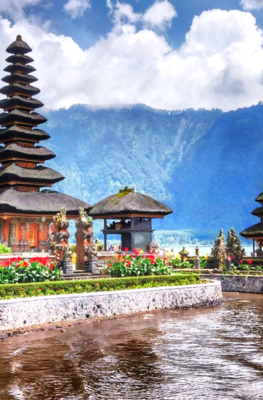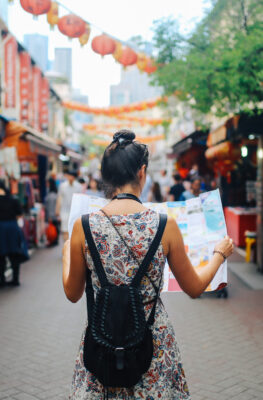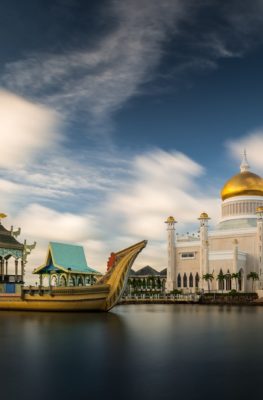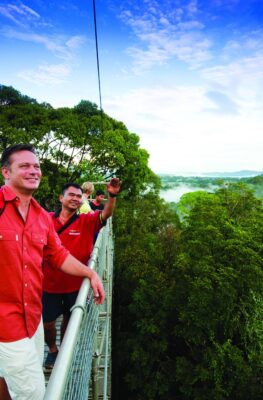Published on February 15, 2010
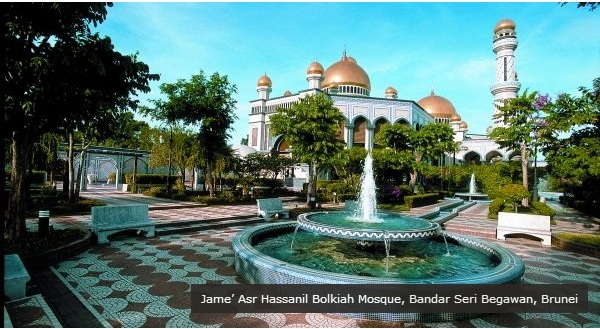
I admit it, I’m an idiot. Before moving to Southeast Asia, I had no clue where Brunei was. I knew it was a Sultanate, I knew the Sultan was rich (and at one time apparently hosted Michael Jackson) and I knew there was no booze. As a result I clicked it off my “places to go” list. Big mistake.
The Location
Apparently Brunei is not in the Middle East, which is what I assumed prior to living in Southeast Asia. Actually Brunei is a tiny country on the tip of the island of Borneo; the same Borneo with one the world’s oldest and most ecologically diverse environments. In other words, Borneo (and subsequently Brunei) has some of the most verdant tropical scenery that you’ll find anywhere. And within that scenery exists the most exotic and rare wildlife; proboscis monkeys, tapirs, orangutans, kingfishers, mangrove forests, huge flowers, huge bats, the list goes on. The Brunei Tourism Organization obviously understands the allure of eco-tourism and the natural treasures they possess. So much so, that the front of their press kit is a photo of nothing but trees and a canopy tower (this photo here), which visitors climb to look out over the lush green canopy.
The Sights
A vast carpet of jungle green is the first thing you notice while gliding down via Royal Brunei Airlines. Poking out of the greenscape is the glittering golden orb atop the Sultan’s palace. The sparkling ball immediately catches your eye, nearly blinding you as it flickers in the late day sun. The Sultan’s residence is unfortunately off-limits to tourists, which is somewhat disappointing as driving by its gates you get a feel for its immense size. The palace is the largest permanent residence of any reigning monarch in the world.
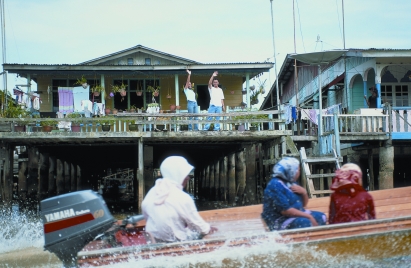
Besides the natural beauty of Brunei, to my surprise, there were many things to keep me busy. Kampung Ayer (water village), a village community built on stilts above the Brunei River, is a popular tour. Set across from downtown Bandar, speedboats take you over the river and into the village area. An astonishing network of piers, houses, schools and above-ground pipes, with lovely welcoming people and smiling kids everywhere, Kampung Ayer is yin compared to the opulent yang of the mosques of downtown Bandar.
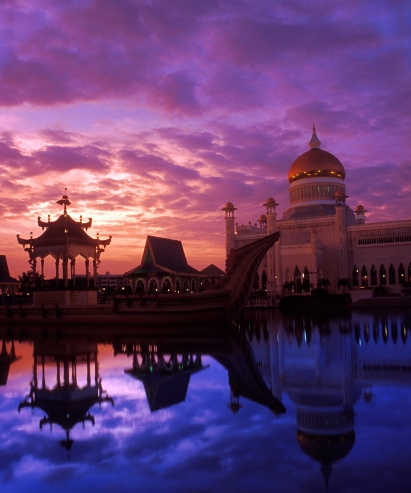
The Sultans’ mosques are truly spectacular and rise above all in Brunei. The glamorous structures are epic reminders of the pervasive Islamic faith that dominates Brunei. We visited two; the oft-photographed, ethereal Sultan Omar Ali Saifuddin Mosque and the commanding Jame’ Asr Hassanil Bolkiah Mosque built by the current Sultan. Both were readying themselves for Friday prayers and only allowed us a quick peek inside; gold trim and marble everywhere, they were indeed awesome settings for the faithful to pray.
The Food
With obvious Malay influences, food in Brunei was fantastic and coronary-inducing.Great smoky barbecue, rich creams, flavorful curries, fried everything, decadent sauces; you name what tastes good and Brunei has included it in their diet.
Our guide (a ridiculously knowledgeable and talkative university student named Reeve) took us to a popular local restaurant Aminah Arif and ordered us a dish called Ambuyat. Ambuyat is a sago dish (similar to taro) with the consistency of what can only be described as “goo”. To say I was skeptical would be an understatement. Rolling the goo onto a pair of conjoined chopsticks, we dipped the gummy lump into a mixture of spices and slid it into our maw. At first it felt like a Hubba Bubba taste-test gone horribly awry, but the mixture of spices made the dish somewhat addicting and quickly filling, as the goo seemed to expand in our stomachs.
Lunch the next day our man Reeve took us to Nasi Kandar Penang, a popular lunch hangout off a main road that served chicken and lamb curries that were wholly addictive. We also visited a food-court in the Yayasan Shopping Complex for some fried chicken sauteed in buttermilk. Why anyone would need to amp up the fat quotient of fried chicken by mixing in buttermilk is beyond me, but let me just say…it was awesome.
However, the highlight of food in Brunei came while visiting Pasar Malam (night market). Two blocks from Brunei’s “The Mall”, the night market looks like a huge barbecue cook-off. Rows of open grills cooking up all sorts of delicacies, at least I think they were delicacies as it was difficult to see beyond my nose due to sheer amount of smoke in the air. It was akin to walking through an early morning London fog, though it smelled significantly better. Barbecued chicken was everywhere, nasi lemak, kebabs, pais daging (meat mixtures cooked in pandan leaves), pulut pangang (rolled rice stuffed with beef or chicken cooked in pandan leaves); we gorged ourselves on the tastes of Brunei and to say we left satiated would be a gross understatement.
The People
I’ve been fortunate enough to visit seven of the ten Southeast Asian nations (as well as a few other countries further north).I’ve enjoyed mingling with locals (at least trying to) in all places and without question the friendliest, most genuine people I’ve encountered are the residents of Brunei. They were always available with a genuine smile, an inquisitive look and were more than willing to engage in quiet and warm conversation, and indulge my inane questions.
The Elephant in the Room
It’s true there isn’t any alcohol in Brunei. Actually, that’s not true, there isn’t any alcohol for sale in Brunei, however they do allow non-Muslim travelers to bring in 2 bottles of alcohol and 12 beer for private consumption. So unless you’re into keggers or drinking out of brown-paper bags, you’re plenty covered with a couple bottles of wine or a bottle of scotch to sip after dinner while watching the sun go down in one of the nicest places in Southeast Asia. Actually if you do live a lifestyle full of keggers and parties, Brunei may actually be an ideal spot for you to travel. An entire country focused on life’s core values while restricting access to your vices would seem a perfect locale for re-centering.
Scott Holmes is an independent filmmaker and freelance writer/ blogger living in Bangkok. He is also the Marketing and Content Manager, as well as Executive Editor, of www.SoutheastAsia.org.



